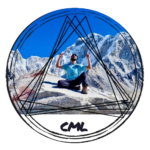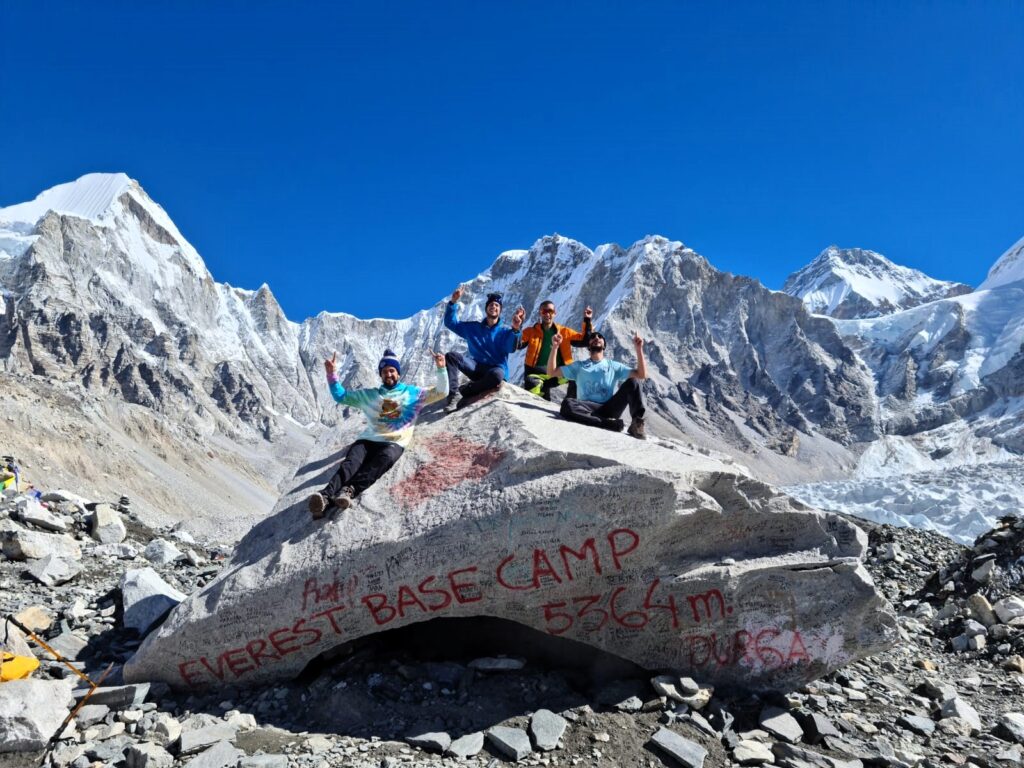While most people fly into Lukla to begin their Everest Base Camp trek, what if I told you there’s a more scenic, less crowded, and cheaper way to start the trek without flying to Lukla? After completing this overland journey by jeep, I want to share my complete guide to this incredible adventure—one that takes you through lush forests, quaint villages, and high-altitude passes. Whether you’re looking for cost-saving tips or an off-the-beaten-path experience, this guide has everything you need to know for an epic and unforgettable adventure in the Himalayas!
Why Skip the Flight to Lukla?
Downsides of Flying to Lukla Airport
As you may know, Lukla’s airport is one of the most infamous in the world. The airport’s location makes it difficult and dangerous for flights to operate due to its high elevation, thin air, short runway, and surrounding mountains. I love flying, but the three Italian friends I trekked to EBC with were not so keen on taking the flight from Kathmandu to Lukla. Beyond the risks of the flight itself, there’s also the possibility of delays and cancellations. If the weather isn’t favorable, you could end up waiting for hours or even days before flying. Lastly, the cost of the flights: around $400 for a roundtrip ticket.
Benefits of Taking a Jeep to Start Your Everest Base Camp Trek
Given the potential issues with flying, we opted for a 2-day jeep journey from Kathmandu to Bupsa, with an overnight stop in Salleri. While the jeep ride wasn’t without its own risks—some sections of the road were rough, bumpy or muddy, and at times we were driving close to cliff edges—the drivers and their 4-wheel-drive vehicles (an Indian brand called Bolero) were incredibly skilled and powerful. Thanks to them, we arrived safe and sound at the starting point of our trek to Everest Base Camp. The jeep journey allowed us to enjoy beautiful sceneries on our Everest Base Camp trek without flying to Lukla. The route was far less crowded than the one starting in Lukla, and the cost was significantly lower than a flight.
Overview of the Jeep Journey from Kathmandu to Bupsa—An Alternative Route to Start the EBC Trek
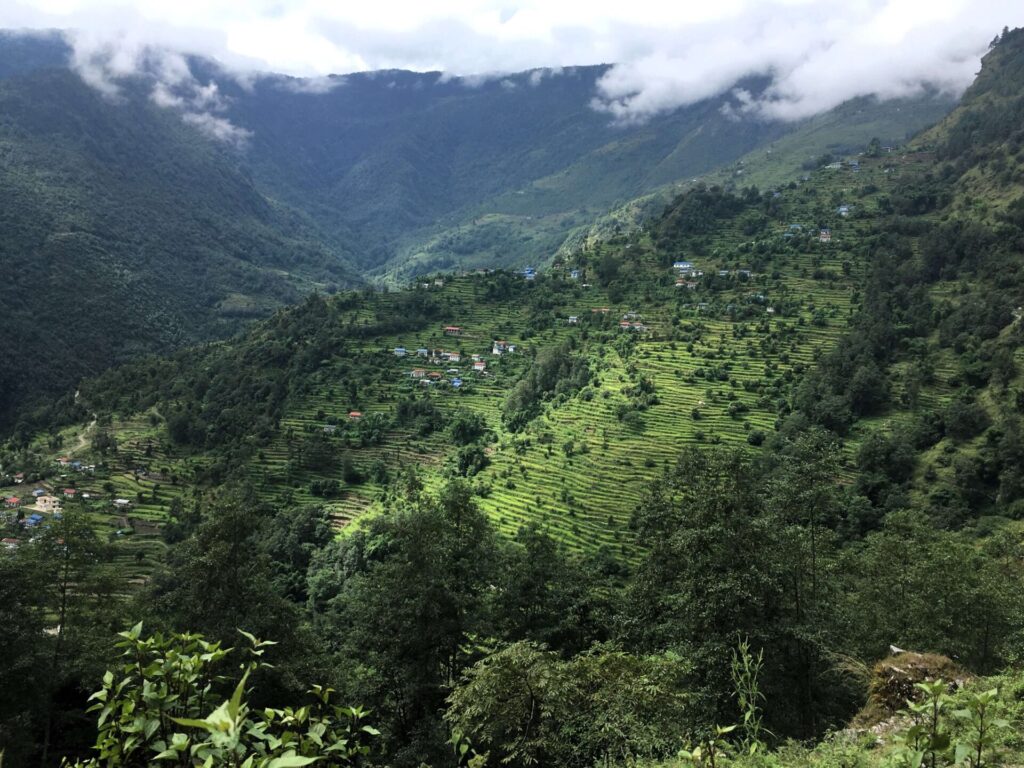
In mid-2023, while planning my Everest Base Camp trek without flying to Lukla, I found limited information on alternative routes. After some research, I discovered a jeep ride from Kathmandu to Bupsa, with a stop in Salleri. I contacted an agency, run by a helpful guy named Rana, to arrange the transportation. While the price was reasonable, it could have been cheaper if we had booked directly with the drivers—something we did on our return journey. You can either contact Rana via his website or ask your guesthouse in Kathmandu for a driver recommendation. If you choose Rana, be sure to mention that Balta sent you!
Jeep Ride from Kathmandu to Salleri—Scenic Drive Through the Himalayas
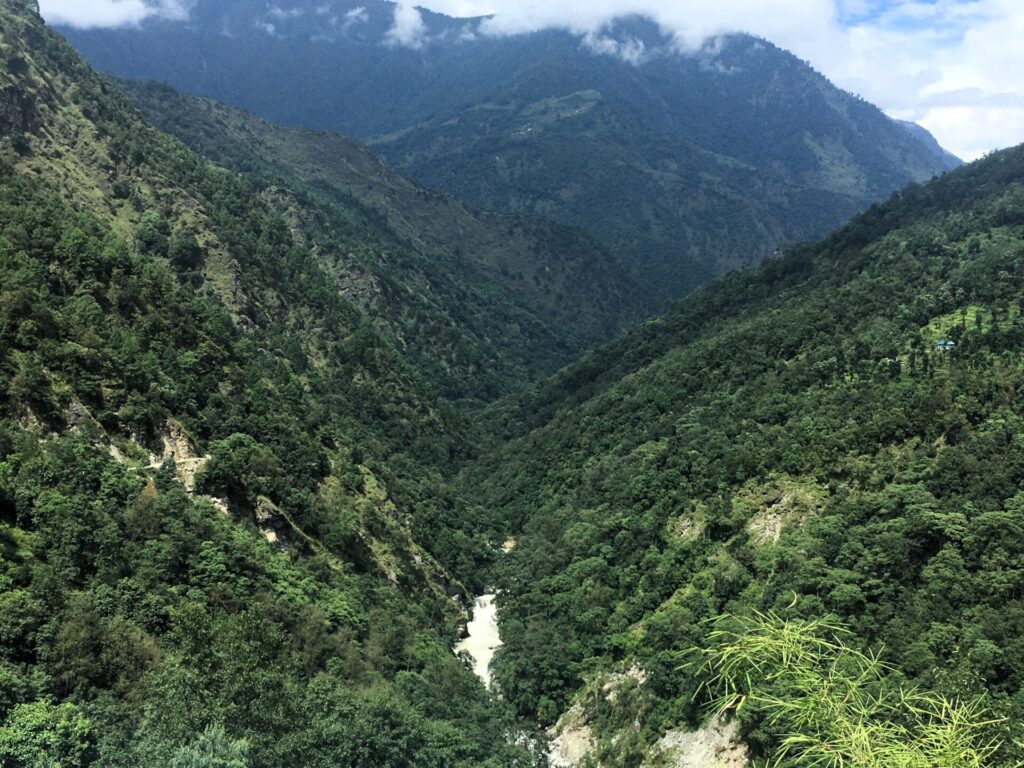
We left Kathmandu around 07:00 after some delays and a cramped start. Our driver drove recklessly, overtaking vehicles despite poor visibility and blasting loud music, though he expertly navigated the rough terrain. Nothing new at this point for me after all my adventures in Southeast Asia, lol. We passed stunning landscapes: rice fields, banana trees, mountain rivers, and waterfalls. As we climbed higher into the Himalayas, pine forests and cliffs came into view. The road was rugged, often covered in mud and rocks. After 11 hours, we reached Salleri at around 18:00 in pouring rain. Despite many guesthouses being full, we found a place to stay and enjoyed our first traditional Nepali meal—dhal bat—before calling it a night.
Jeep Ride from Salleri to Bupsa—The Start of the EBC Trek
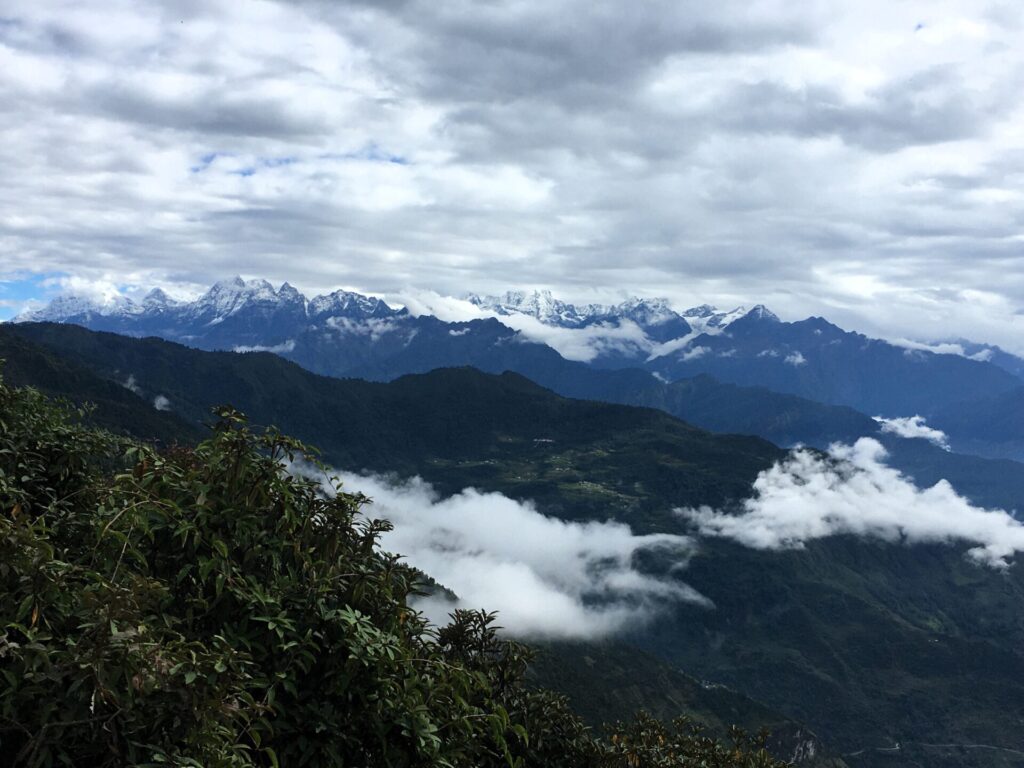
The second day brought more rough terrain, with narrow, treacherous roads often feeling like a dry riverbed. Cramped in the back seat, we navigated muddy paths, crossed waterfalls, and skirted high cliffs that made the ride feel dangerous. Despite the discomfort, the scenic Himalayan views—including snow-capped peaks—were breathtaking. Our driver was skilled, polite, and thankfully kept the music low. After several hours, we safely arrived in Bupsa. From there, we hiked 3.5 km in the rain to Kari La Lodge, arriving just before a heavy downpour. The warm fire, cozy room, and ginger lemon tea were the perfect way to end the day.
Travel Tip for the Jeep Journey from Kathmandu to Bupsa—How to Make Your EBC Trek More Comfortable
“Experience is what you get when you don’t get what you want”. Luckily, we got exactly what we wanted: we arrived safe and sound in Bupsa to start our Everest Base Camp trek without flying to Lukla. However, I must admit that the jeep ride could be long and uncomfortable at times. On our return from EBC to Kathmandu, we decided to pay for two extra seats, and it made a huge difference in comfort. So, if you’re traveling in a group, I highly recommend booking one additional seat for more space. For instance, if there are three of you, book four seats. You’ll be grateful for the extra room during the journey! 😉
EBC Trek Day-By-Day Itinerary
Day 1: Trekking from Bupsa to Surke—Serene Landscapes and Traditional Sherpa Villages

- Distance: 9.5 km
- Duration: 5 hours
- Elevation: Descend from 2800 m to 2300 m
- Highlights: Quiet alternative route, narrow cliffs, traditional Sherpa villages, donkeys carrying supplies, and untouched rural landscapes.
- Accommodation: Everest Trail Lodge Yak & Yeti Cafe Home
The rainy, foggy conditions made the trek tough, with mud and slippery rocks challenging our progress. However, the peaceful, less-traveled path gave us a unique perspective. Meeting Sherpas carrying heavy loads in minimal gear reminded us of the resilience and strength of the local people. Some of them were carrying loads of up to 60 to 80 kilos. I tried to stand up with one of 65 kg and it was very tough! Why do we make the world such that depending on the place you are born your life changes so much?
Our stay at Everest Trail Lodge was a cozy end to the day, complete with friendly conversations with the owner and her daughter and with raksi, a traditional local wine.
Day 2: Trekking from Surke to Monjo—Breathtaking Views and Encounters With Locals
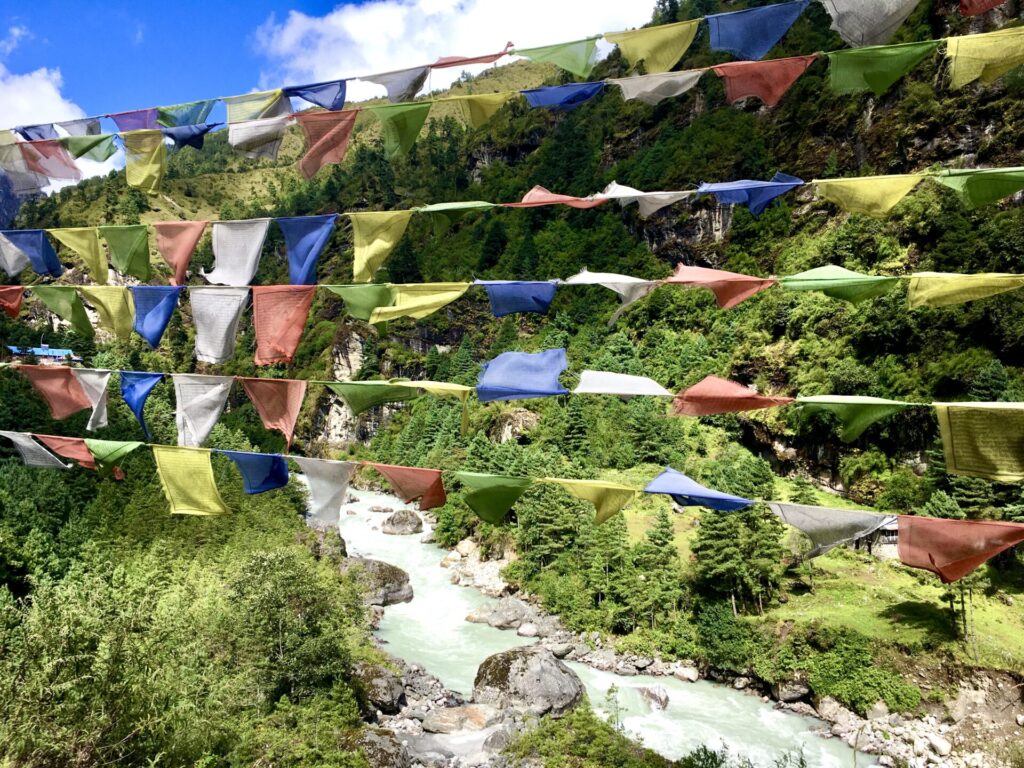
- Distance: 15 km
- Duration: 5 hours
- Elevation: 2300 m to 2800 m
- Highlights: Suspension bridges, sunny weather, and meeting a local Nepali student.
- Accommodation: Random guesthouse in Monjo
For breakfast, we had tsampa porridge with banana, which was both filling and energizing. With no clouds, the views were breathtaking, and we crossed our first set of suspension bridges, with many more to come. Along the way, we met a friendly 17-year-old Nepali student returning home for the holidays from Kathmandu. He walked with us for part of the journey, explaining the local culture, including that many of the scriptures we saw were written in Sherpa language, not Sanskrit.
We stopped for lunch in his hometown, at Green Village Guesthouse, a bit more touristy than what we were used to. The owner, Michael, recommended staying at Namaste Lodge in Namche Bazaar, which we kept in mind for later. After a few conversations, including an interesting one with an Indonesian traveler on a 5-year vacation, we reached Monjo faster than expected—just 2.5 hours instead of the estimated 3. ¡Vamos!
Day 3: Trekking from Monjo to Namche Bazaar—Crossing the Iconic Hillary Bridge

- Distance: 5 km
- Duration: 2.5 hours
- Elevation: 2800 m to 3400 m
- Highlights: Hillary Bridge, checkpoint for drones, and bustling Namche Bazaar.
- Accommodation: Namaste Lodge
Today was the toughest trek so far, with a steep climb from 2800 m to 3400m in just 5 km. Except for a brief section, the trail was mostly uphill, which made it tiring but absolutely beautiful. We crossed the famous Hillary Bridge with its two suspension bridges, a true highlight. Shortly after leaving Monjo, we passed through a checkpoint where officials were searching for drones. I’m glad I decided not to bring mine! The trail was busy with trekkers who had flown into Lukla, and the clear weather meant I was sweating heavily. Luckily, my legs and back felt stronger.
We reached Namche Bazaar by 11:00 and were amazed at how big and busy it was compared to the villages we’d passed. The Namaste Lodge was a great place to stay, but like most accommodations here, the meals were pricey since that’s how they make money. That’s common during the EBC trek. They make money out of meals, showers, wifi and charging. Rooms are quite cheap or even free most of the times. After washing clothes at a local fountain and exploring the town, we ended the day at the Hungry Yak, enjoying live music before heading to bed.
Day 4: Acclimatization Day in Namche Bazaar—Hiking to Khumjung
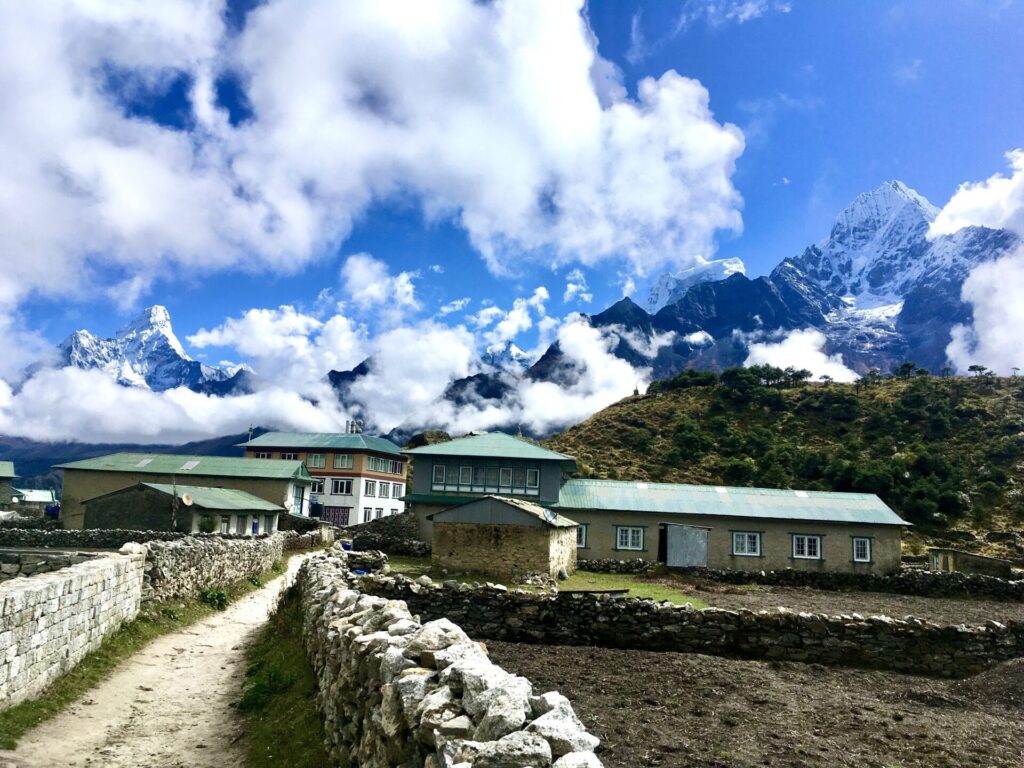
- Distance: around 10 km roundtrip
- Duration: 8 hours
- Elevation: 3400 m to 3800 m and back
- Highlights: Stunning views of Lhotse and Ama Dablam, yak sightings, and an environmental initiative.
- Accommodation: Namaste Lodge
We woke up at 06:00 and left by 07:00 for an acclimatization day. We trekked from 3400 m to 3800 m, taking our time with long breaks. Despite a slight headache, I was determined to take things slowly and adapt. The views were breathtaking, with Lhotse (8516m) and Ama Dablam (6812 m) making the climb worthwhile, even though Everest was hidden behind the clouds. Our hike led us to the Everest View Hotel, where Japanese mountain photography adorned the walls. We spotted our first yak, which was a magnificent sight—larger than I expected and covered in wool.
Continuing our trek to Khumjung, we enjoyed its charm—fewer tourists, local shops, and a temple, all covered by clouds sitting at 3800 m. On our return to Namche, we stopped by Sagarmatha Next, an initiative addressing the garbage issue in the Khumbu region, featuring an art gallery made from waste and a documentary on environmental awareness.
Day 5: Trekking from Namche Bazaar to Pangboche—The First Glimpses of Mount Everest

- Distance: 13 km
- Duration: 5 hours
- Elevation: 3200 m to 3800 m and back down, then up again. 1000 m in total.
- Highlights: First glimpses of Mount Everest, Tengboche Monastery, and a cozy stay in Pangboche.
- Accommodation: Pangboche Namaste Lodge & Restaurant
We left Namche Bazaar at around 07:20, starting a steep climb that tested my endurance. Breathing was tough, partly due to the altitude and partly because I was shaking off a cold. The trail was demanding, but after about 3 hours, we arrived in Tengboche, with its famous monastery. The final km to Tengboche was especially challenging, similar to the climb from Monjo to Namche Bazaar but twice as long. But our first clear view of Mount Everest, sitting majestically beside Lhotse, made it all worth it. Ama Dablam was also visible, as impressive as ever. We took a short rest in Tengboche before deciding to push on to Pangboche.
Pangboche was larger and livelier than Tengboche, and our lodge host was fantastic—kind and full of energy. She even gave me a herbal remedy to help with my cold. We enjoyed a hearty lunch of massive vegetarian spring rolls, and later, by the fire, we shared stories with other trekkers. After some dhal bat, we called it a night, ready for the next day’s adventure.
Day 6: Trekking from Pangboche to Dingboche—Walking in the Shadow of Ama Dablam
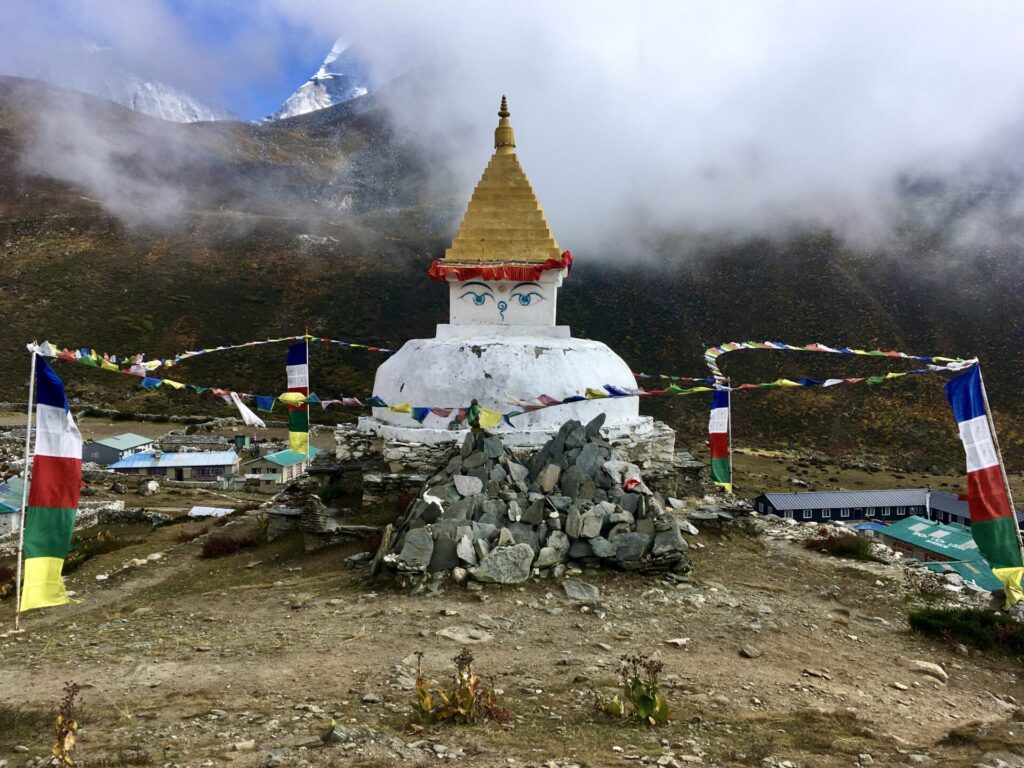
- Distance: 6.5 km
- Duration: 3 hours
- Elevation: 3900 m to 4400 m
- Highlights: Stunning views of Ama Dablam, yak sightings, valleys and rivers.
- Accommodation: Solokhumbu Hotel
I woke up early, catching a glimpse of the starry sky and Ama Dablam from the window before falling asleep again. After a breakfast of samosas, we set out later than usual. The landscape was the most breathtaking so far, with Ama Dablam, Everest, and Lhotse towering in the distance. The clear skies added to the beauty—everything blue and white. We took our time, walking through a valley along the yak milk river, spotting yaks, even some baby ones!
As we neared Dingboche, the mountains grew closer. Once in the village, we found a cozy place to stay with free Wi-Fi and charging. For lunch, we discovered a local house offering simple but delicious dishes like dhal bat and noodles. I spent the afternoon exploring Dingboche, enjoying its stunning views and trying to avoid napping to aid acclimatization. After a hearty dinner, I got some good rest for the next day.
Day 7: Acclimatization Day in Dingboche—Reaching our first 5000 m at Nangkartshang Peak
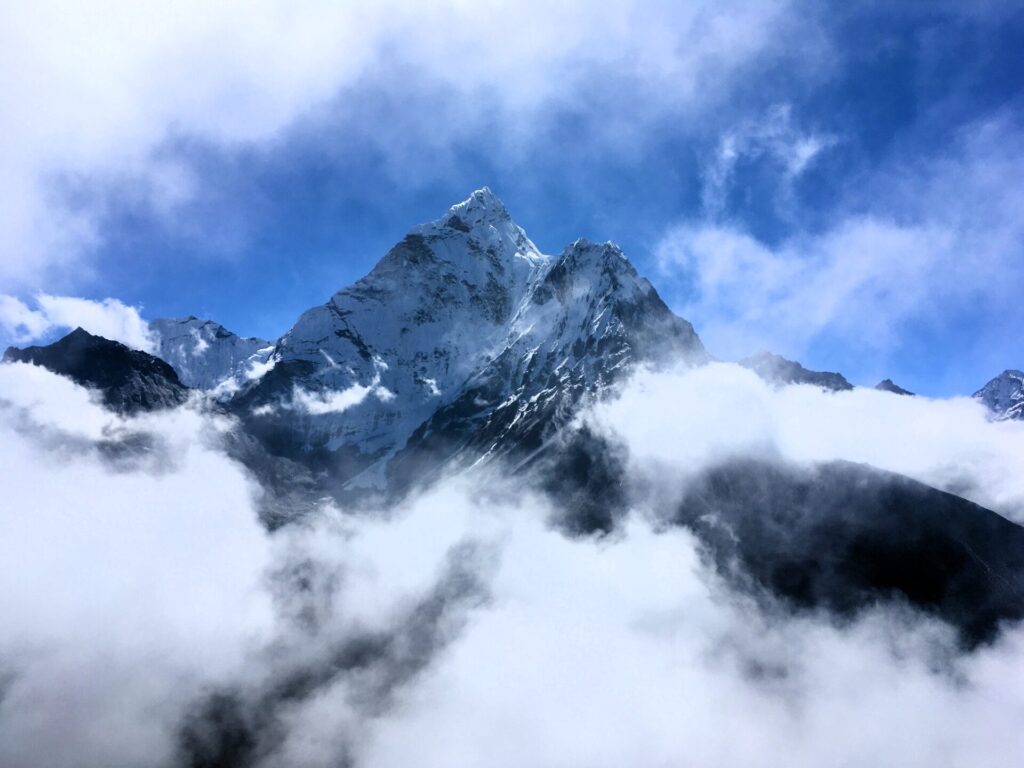
- Distance: 2.2 km
- Duration: 2 hours
- Elevation: 4400 m to 5000 m
- Highlights: Foggy summit, meeting fellow trekkers, and panoramic views of Ama Dablam.
- Accommodation: Solokhumbu Hotel
We set out at 08:00 for a short but intense hike to 5000 m, covering just 2.2 km in two hours. The first 500 m took us off the beaten path, straight up without a trail—an excellent workout for what was to come. The views of Ama Dablam and the valley below were breathtaking. I don’t know how many photos and videos I took of Ama Dablam, but it was probably the most beautiful and impressive mountain I’ve ever seen.
At the top, we met fellow trekkers, including some Nepali police officers and two Spaniards. Though the mist obscured the views, the atmosphere was magical—sharp rocks, prayer flags, and spontaneous singing from the Nepali group. After an hour at the summit, we made our way down, running at times to ease the strain on our knees. Back at the lodge, we rested, chatted with Victoria, a trekker from Argentina, and enjoyed a dinner of fried rice before calling it a day.
Day 8: Trekking from Dingboche to Lobuche—A Tribute to Everest’s Legends
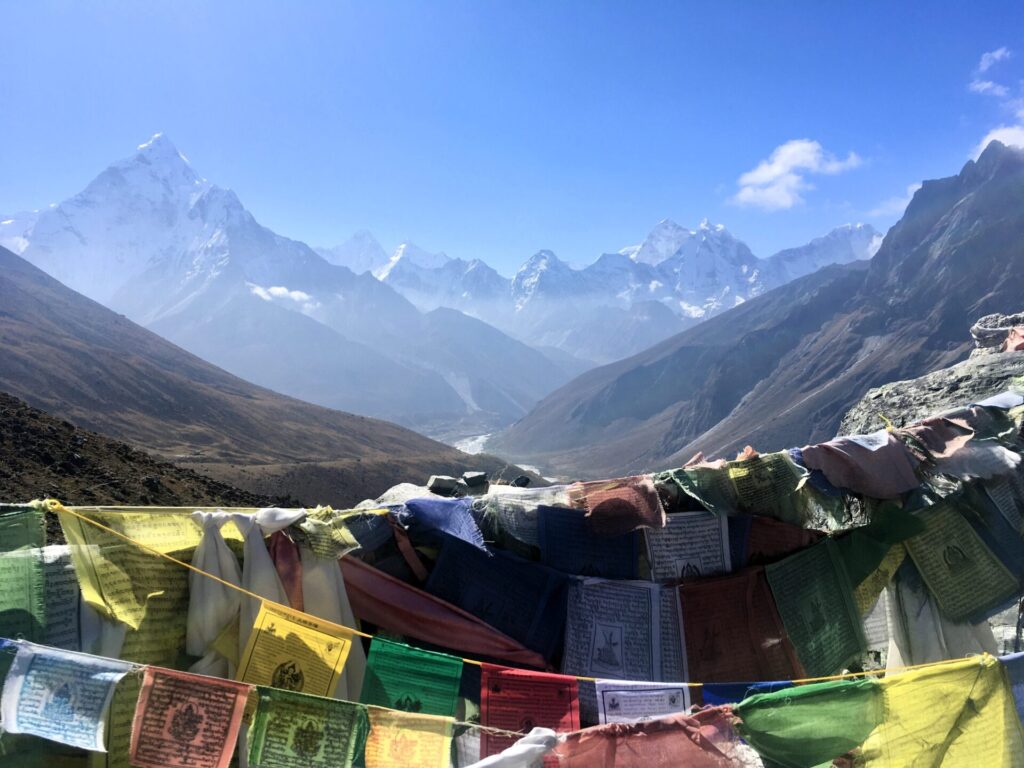
- Distance: 8 km
- Duration: 3 hours
- Elevation: 4400 m to 4900 m
- Highlights: Memorial site for fallen climbers, views of Nuptse I, and a challenging ascent.
- Accommodation: Random lodge in Lobuche
After an early breakfast at 06:30, we hit the trail by 07:15. The first ascent from Dingboche was tough, reminding me of the climb out of Namche Bazaar. I felt heavy after breakfast, but we pushed through, leaving behind Ama Dablam, Dingboche, and the valley. The trail leveled out into a beautiful plain, passing a distant lake and a river. Halfway to Lobuche, we took a break at a café. The next challenge was a steep, wall-like ascent, which felt like a Tibetan wall.
Slowly but steadily, we reached the top, greeted by prayer flags and a sombre memorial—a cemetery honouring climbers who died on Everest. It was a powerful reminder of the risks and dedication of those who pursue their dreams. After that, the path became rockier, but easier. A river on our right side and Nuptse I were a truly gift to our eyes. We reached Lobuche, secured a room at a discounted rate (500 rupees instead of 1000), and enjoyed lunch in a nearby tent. Dhal bat, once again, did the trick, as we prepared for the next day’s adventure to Everest Base Camp and Kala Patthar.
Day 9: Exceeding the Limits—Conquering Everest Base Camp and Kala Patthar
- Distance: 18 km (16 km from Lobuche to EBC and back and 2 km of ascent to Kala Patthar)
- Elevation: 4900 m to 5364 m (EBC) and 5644 m (Kala Patthar)
- Duration: 9 hours (including both treks)
- Highlights: Everest Base Camp, Khumbu Glacier, Kala Patthar, and the view of Mount Everest’s summit.
- Accommodation: Random lodge in Lobuche
1) Lobuche to EBC (8 km, 4900 to 5364 m)

Like everything I’ve set my mind to, this too was conquered with willpower, though it wasn’t easy. Both today and the next pushed me to my physical and mental limits, but they were some of the most stunning and surreal experiences of my life. The trek from Lobuche to Everest Base Camp was tough, but the excitement of reaching the highest base camp in the world kept me going. We arrived to an almost empty site, making the moment even more special. Seeing Khumbu Glacier up close and leaving a wristband from my village (Valdepeñas de Jaén) among the Tibetan prayer flags made it unforgettable.
2) Gorakshep to Kala Patthar (2 km, 5164 to 5644 m)
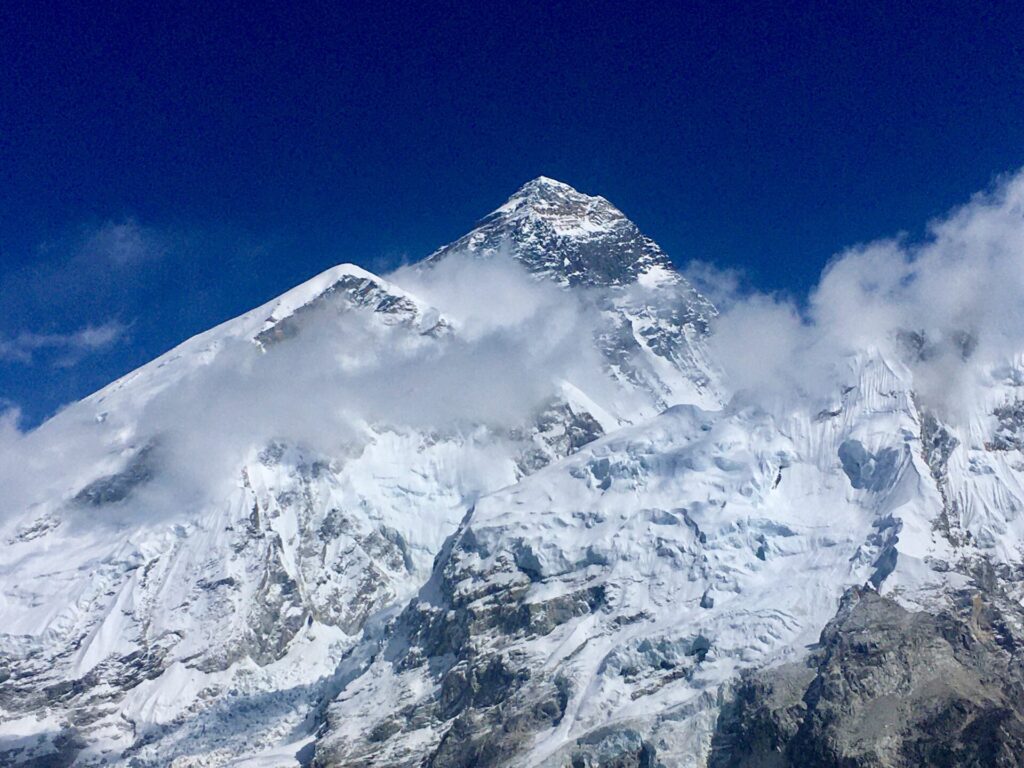
The real challenge came when we decided to climb Kala Patthar. The 2 km hike was deceptively difficult, with the thin air and exhaustion making each step a struggle. We were close enough to see its summit, but the clouds had other plans for us. Yet, as if the Gods of the Mountains wanted to show their appreciation for our efforts, as we were getting closer to the summit of Kala Patthar, the clouds danced away from Mount Everest, revealing the summit of the highest mountain in the world. The climb took its toll—dizziness, fatigue, and headaches made the descent a real challenge. Yet, despite the pain, the sense of achievement was overwhelming. It was a day that tested every ounce of strength but will stay with me forever.
Day 10: Trekking from Lobuche to Gokyo Lake via Chola Pass—A Challenging and Scenic Everest Adventure
- Distance: 19 km
- Elevation: 4900 m (Lobuche) to 5370 m (Chola Pass) to 4750 m (Gokyo Lake)
- Duration: 10 hours
- Highlights: Crossing Chola Pass, Ngozumba Glacier, and arrival at Gokyo Lake.
- Accommodation: Gokyo Namaste Lodge and Restaurant
1) Lobuche to Dzonghla (6.3 km, 4900 to 4700 m)
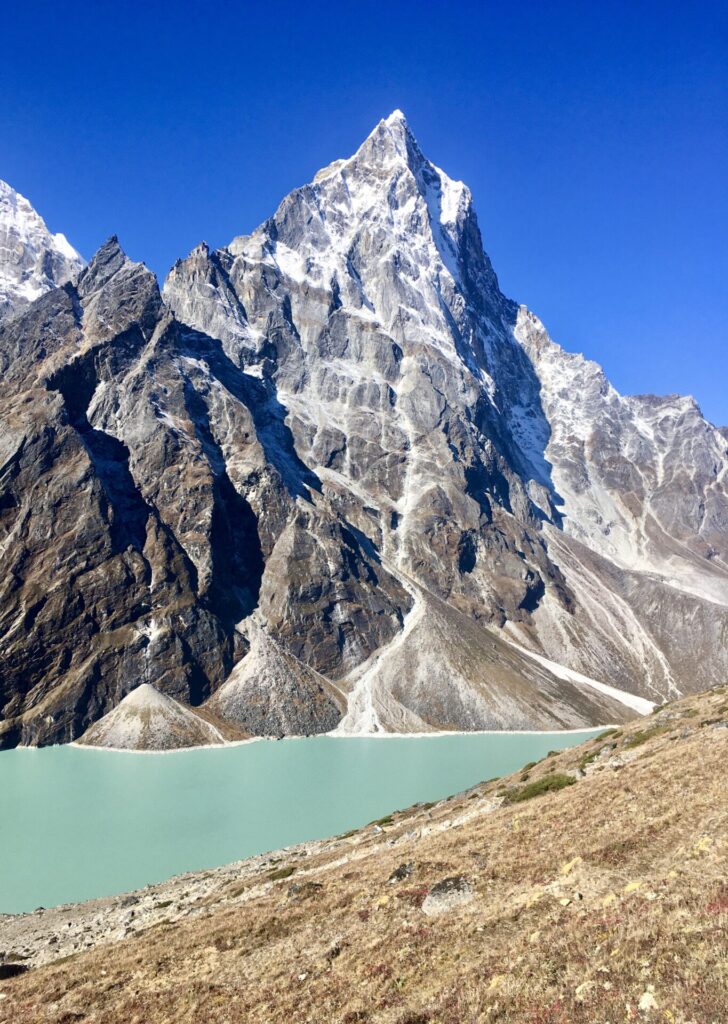
This section took us through a scenic snowy valley with frozen vegetation and a narrow path along the hills. Behind us were the towering mountains of EBC, while ahead, a stunning green lake emerged as we approached Dzonghla. This part wasn’t too tough, and we arrived in a couple of hours, took a short break, and prepared for the harder stretch ahead.
2) Dzonghla to Dragnag (8.8 km, 4750 to 5370 to 4675 m)
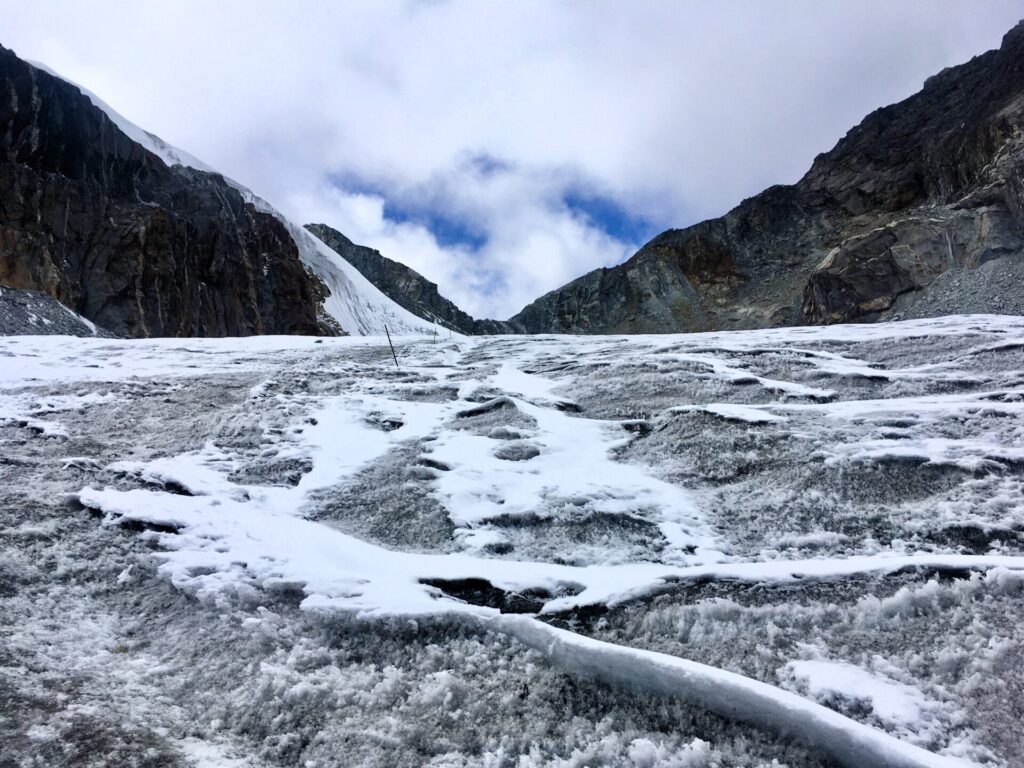
Crossing Chola Pass was the hardest section of the day. The terrain turned rocky, steep, and slippery as we ascended past 5000 m again. Reaching the glacier at Chola Pass was a thrilling moment—walking across its vast expanse of ice and snow, hearing water rushing beneath us, and seeing the snowy mountains behind. We eventually descended to Dragnag, where we took a well-earned rest before the final stage.
3) Ngozumba Glacier to Gokyo Lake (4 km, 4675 to 4750 m)

The last stage was the most surreal. The landscape turned into a rocky, foggy terrain, as we navigated the treacherous Ngozumba Glacier. It felt like a “dumpster of rocks,” and we got lost for a while, but eventually found our way thanks to helpful rock piles and blue arrows. By the time we reached Gokyo Lake and the village, it was late afternoon. Exhausted but proud, we settled into our hostel and enjoyed a well-deserved rest with incredible views of the lake.
Day 11: Trekking from Gokyo Lake to Namche Bazaar—23 km Through Fog and Mountains

- Distance: 23 km
- Elevation: 4750 m (Gokyo Lake) to 3440 m (Namche Bazaar)
- Duration: 7.5 hours
- Highlights: Foggy rainbow over Gokyo Lake, forested landscape near Dole, and a steep ascent.
- Accommodation: Khumbu Lodge
After two physically demanding days, we embarked on the 23 km trek from Gokyo Lake to Namche Bazaar. It was the coldest morning of the trek, with the beautiful blue lake surrounded by snow-capped mountains. The fog soon covered the landscape, but we were able to appreciate a foggy rainbow over Gokyo Lake.
The first part of the trek was relatively easy, with plain terrain and the occasional stunning lake. But things got tougher as we approached Dole, where we tackled a steep 300-meter ascent over 1.5 km. This was one of the hardest sections, but we persevered, taking breaks and enjoying the views as we ascended into the forest. The last part of the trek felt like an endless descent with countless steps, but we eventually made it to Namche Bazaar after 7.5 hours, arriving at Khumbu Lodge, where we could finally rest and recover from the long day.
Day 12: Trekking from Namche Bazaar to Surke—A Welcome Break from Altitude
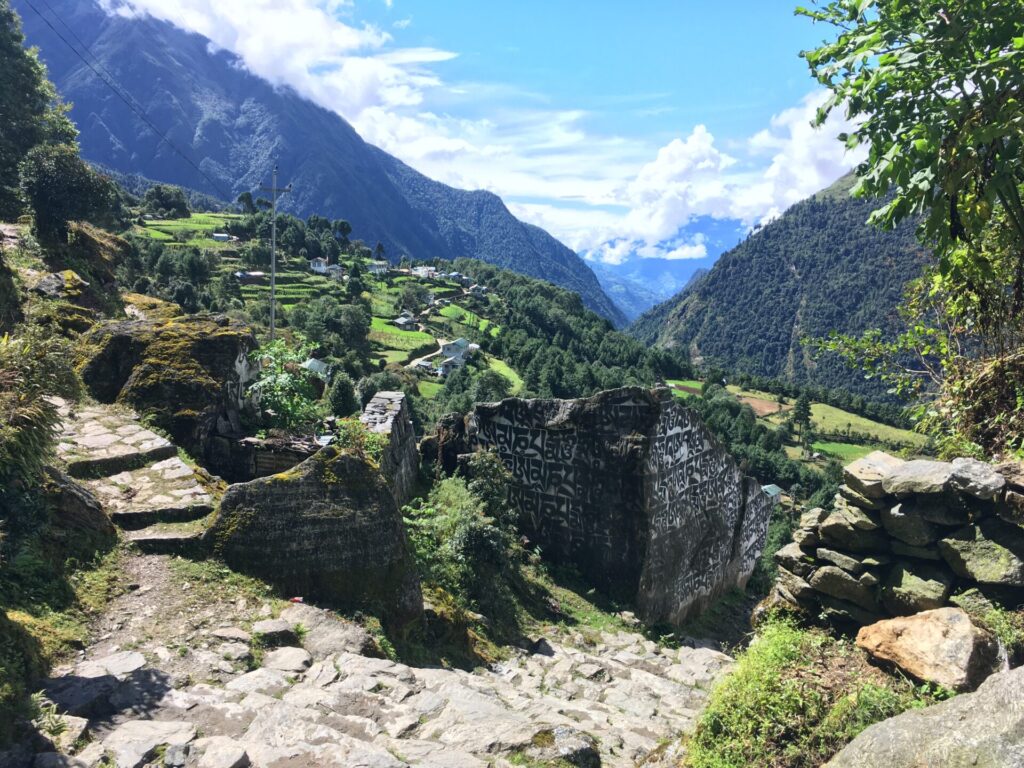
- Distance: 20 km
- Elevation: 3400 m (Namche Bazaar) to 2300 m (Surke)
- Duration: 6.5 hours
- Highlights: Tibetan bridges, lower altitude, and donkey trains.
- Accommodation: Everest Trail Lodge Yak & Yeti Cafe Home
After several tough days, the trek from Namche Bazaar to Surke felt simpler but still challenging. Covering 20 km, the descent from 3400 m to 2300 m provided noticeable relief from the effects of high altitude, making breathing easier and restoring my energy. This stretch was a great reminder of how lucky we were to have started the Everest Base Camp trek without flying to Lukla, avoiding the flight delays many other trekkers faced due to bad weather.
We crossed several Tibetan bridges, always a highlight, and encountered familiar landscapes. Along the way, we were briefly held up by donkey trains. Seeing the donkeys mistreated by their handlers made me reflect on their hardships. The path felt easier with the lower altitude, and we maintained a strong pace, stopping for a much-needed lunch. By 15:00, we reached Surke and were welcomed back by Bepa and her mom at the Everest Trail Lodge. It was a comforting return to a familiar, warm atmosphere after a long but rewarding day.
Day 13: Trekking from Surke to Bupsa—Battling Sickness on the Trail
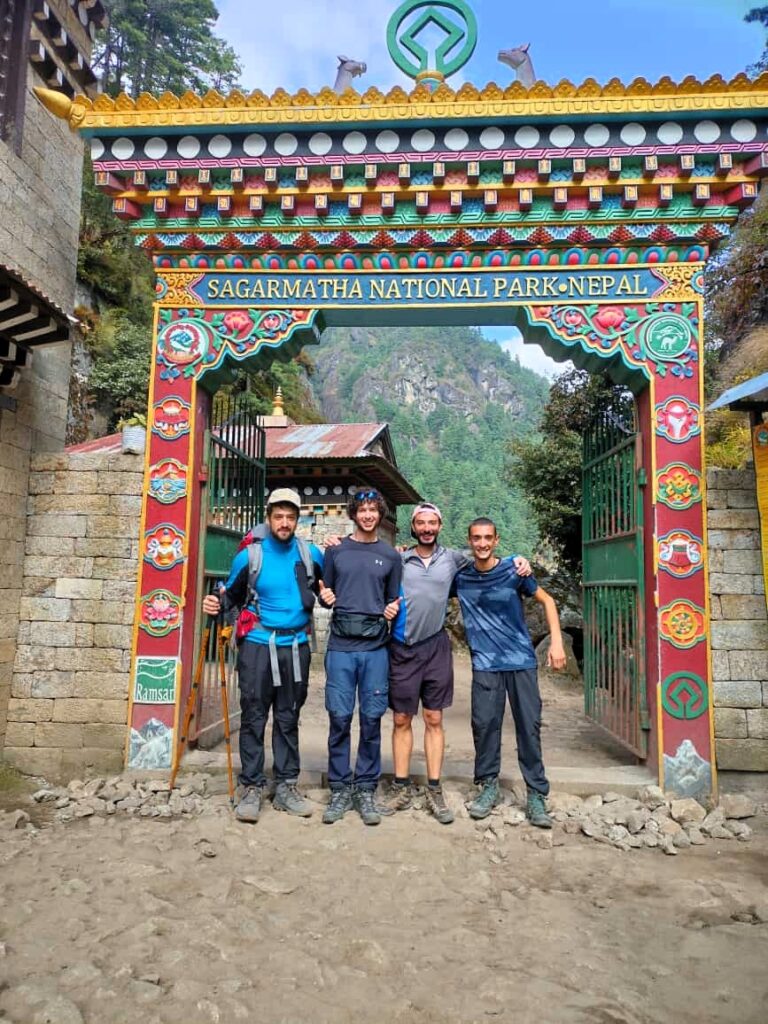
- Distance: 14 km
- Elevation: 2300 m (Surke) to 2350 m (Bupsa)
- Duration: 7 hours
- Highlights: Challenging muddy detour and enduring illness.
- Accommodation: Local guesthouse in Bupsa
Day 13 was tough, not just because of the terrain but because illness hit our group. Cristian had stomach pain, and Nicola was battling a cold, so we moved slowly, taking frequent breaks. The first steep ascent was challenging, with many steps that made it feel longer than it was. Midway through, we had to take a detour after being informed that our original route was blocked. The new path was muddy, steep, and dangerous at times, adding an extra layer of difficulty to an already exhausting trek.
Despite the challenges, we managed to push through. By the time we reached Bupsa, I began feeling sick myself. What started as discomfort soon escalated to stomach pain, nausea, and fever-like symptoms. I skipped dinner and spent a restless night in bed, feeling miserable but slightly improving by the morning. Nobody said climbing the highest base camp in the world was easy 😅
Final Jeep Ride on the Everest Base Camp Trek—Bupsa to Kathmandu
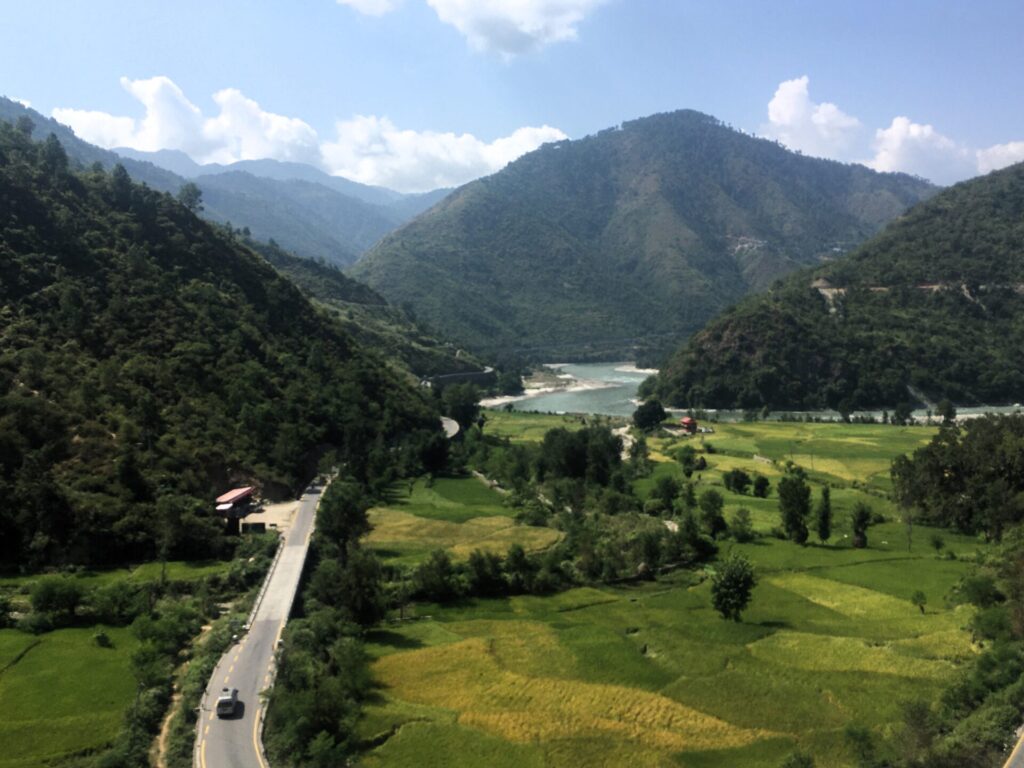
Everything that comes eventually goes, and just like that, our Everest Base Camp trek without flying to Lukla came to an end. I’ve been fortunate to live through incredible adventures, but nothing compares to the unique and breathtaking experience of this trek.
Jeep Ride from Bupsa to Salleri—A Himalayan Off-Road Adventure
Our final day began with a short 10-minute walk from the guesthouse to meet the jeep driver—our last walk on the Everest Base Camp trail. Having purchased two extra seats made the long, bumpy ride slightly more comfortable, though the 6-hour journey on Nepal’s rugged mountain roads was still challenging. The steep terrain, sharp turns, and narrow pathways kept us on the edge throughout.
Still recovering from my earlier stomach issues, the constant shaking didn’t help. However, the scenic views of the Himalayan landscape provided moments of awe. After stopping for lunch—where I cautiously stuck to plain rice—we continued the off-road journey. Despite my discomfort, we arrived safely in Salleri. It was a relief to be off the jeep and realize that the adventure, though thrilling, was nearing its end.
Jeep Ride from Salleri to Kathmandu—A Smoother, Scenic Journey
While the road from Salleri to Kathmandu wasn’t as rugged as the one from Bupsa, it was still a lengthy, winding drive. The journey stretched on for hours, and though the road was more manageable, its length made it tiring. The driver was calmer this time, without the loud music or constant overtaking that had characterized our previous ride. The quieter atmosphere made the trip more relaxing and enjoyable.
We finally arrived in Kathmandu at around 16:30, having spent about 12 hours on the road. Once back in the city, we unpacked our bags, took refreshing showers, and went out to celebrate the milestone of having conquered Everest Base Camp! It wasn’t a wild celebration, though. We enjoyed a peaceful dinner at Forza Pizza, treated ourselves to gelato at a nearby mall, and headed back to the hostel, exhausted but fulfilled 🙂
Practical Tips for the Everest Base Camp Trek Without Flying to Lukla
If you’re planning to take on the Everest Base Camp trek without flying to Lukla, preparation is key to ensuring a successful and enjoyable experience. Here are some practical tips covering everything from permits and packing to fitness and budgeting.
Permits and Documentation for the EBC Trek
For the Everest Base Camp trek, you’ll need a couple of important permits:
- Sagarmatha National Park Permit: Since EBC is located in Sagarmatha National Park, you’ll need this permit, which is available at the entry point of the park in Monjo or in Kathmandu at the Nepal Tourism Board Office. It costs 3000 rupees per person.
- Khumbu Pasang Lhamu Rural Municipality Entrance Permit: This new permit was imposed on the 1st of October 2018, replacing an existing TIMS Card. It costs 2000 rupees per person. This permit cannot be obtained in Kathmandu. You can obtain it in Lukla (if you are flying there) or in Monjo (if you start your trek from Salleri or Bupsa).
Best Time to do the EBC Trek
The best times to do the Everest Base Camp trek without flying to Lukla are the pre-monsoon (March to May) and post-monsoon (September to November) seasons.
- Pre-monsoon (March-May): You’ll enjoy warmer temperatures and blooming rhododendrons, but it can be a bit hazy at lower altitudes.
- Post-monsoon (September-November): The skies are typically clear, offering excellent views, but it can get colder as you approach winter.
During these times, daytime temperatures are pleasant for trekking, but it can drop significantly at night, especially at higher altitudes. Always be prepared for sudden weather changes, as mountain weather can be unpredictable.
Packing List for the EBC Trek Without Flying to Lukla
Packing the right gear is essential for a comfortable trek. If you are not someone who is always in the mountains, I recommend to rent some of the trekking gear instead of buying it. You can take a lot at some of the shops in Thamel Street. Here’s a basic list of what you’ll need:
- Clothing: Layering is crucial. Pack lightweight, moisture-wicking base layers, fleece for warmth, and a down jacket for higher altitudes. Don’t forget waterproof gear like a rain jacket and pants.
- Footwear: Bring broken-in, waterproof trekking boots with good ankle support. Also, pack a pair of comfortable shoes for the evenings.
- Trekking Essentials:
- Trekking poles (important for stability on rugged terrain). In my case, I didn’t use them, but I saw quite some people using them. I would say it is something personal.
- Sleeping bag rated for at least -10°C (some lodges have blankets, but it gets cold). In my case, I rented one in Kathmandu, instead of buying it. I used it just two nights because the blankets at the guesthouses were enough for me.
- Headlamp with extra batteries.
- Water purification tablets or a water filter bottle. My friends were using the tablets. I was using the LifeStraw bottle instead. They both worked great.
- Miscellaneous:
- Sunscreen, lip balm, and sunglasses (the sun at altitude can be intense).
- First aid kit with altitude sickness medication (Diamox), blister care, and any personal medicines.
- Snacks like energy bars and nuts for extra fuel between meals.
Fitness Level and Preparation
The Everest Base Camp trek without flying to Lukla requires a moderate to high level of fitness, as you’ll be trekking for over two weeks, covering 154 km on foot. In our case, we didn’t train for it in advance but we do sport regularly. What we all felt the most wasn’t the difficulties in the terrain or the steep sections, but the lack of oxygen at higher altitudes. It made a huge difference. Thus, my personal advice is that you don’t overdo it, take it at your own pace and rest when needed it so you increase your chances to avoid altitude sickness.
Everest Base Camp Trek Without Flying to Lukla FAQ

1. How Much Does the Everest Base Camp Trek Cost Without Flying to Lukla?
The total cost of my Everest Base Camp trek, without flying to Lukla, was approximately €400. This included a two-day jeep ride from Kathmandu to Bupsa and back, the two permits required, as well as food, drinks, and accommodation for 16 days. We chose to do the EBC trek without a guide or porter, which helped reduce the overall cost.
The biggest savings came from skipping the Lukla flight, which costs about $200 one way. Instead, we opted for a $85 roundtrip jeep journey, which added adventure to the experience while saving money. On average, we spent 2500 rupees per night, covering dinner, breakfast, Wi-Fi, charging, and a bed. Hot showers ranged from 300 to 700 rupees, while Wi-Fi costs were similar.
2. How Long Does the Everest Base Camp Trek Take Without Flying to Lukla?
Our trek took 14 days of walking and an additional 4 days of jeep travel, covering 154 km on foot. Since we did the EBC trek without flying to Lukla, the journey to Everest Base Camp took 10 days, including the two recommended acclimatization days. We returned in to Namche Bazaar in 2 days, hiking 44 km from Lobuche via Gokyo Lake. The duration of your trek will depend on your physical fitness and how many acclimatization days you choose to take.
3. How Difficult Is the Everest Base Camp Trek Without Flying to Lukla?
The Everest Base Camp trek without flying to Lukla adds extra days of hiking and jeep travel, making it more challenging in terms of endurance. I had previously hiked Mount Fuji (3765 m) and Mount Kinabalu (4096 m), but I still struggled with altitude sickness on this trek.
At Namche Bazar (3400 m), I experienced headaches and shortness of breath, but, funny enough, it got better as I ascended. The trek to Lobuche and Kala Patthar was especially tough due to the altitude. Overall, the EBC trek was a physically demanding experience because of the altitude’s impact on stamina and energy levels.
4. What Amenities Are Available on the Everest Base Camp Trek?
Along the Everest Base Camp trek without flying to Lukla, accommodations are basic but comfortable. You typically pay little or nothing for the bed, and in return, you’re expected to eat dinner and breakfast at the guesthouse. If you dine elsewhere, the cost of the bed may increase, which is common practice throughout the trek.
Most places offer Wi-Fi, hot showers, and charging points, though these come at an extra charge. Expect to pay 300 to 700 rupees for a hot shower or Wi-Fi. For those looking to save money, cold showers are free!
Personal Reflection on the Everest Base Camp Trek Without Flying to Lukla

Completing the Everest Base Camp trek without flying to Lukla has been the most unique and special adventure of my life. Trekking through remote villages, crossing suspension bridges, and experiencing the majestic beauty of the Himalayas with every step felt surreal. The journey was physically and mentally challenging, especially with the added length of the trek compared to the traditional Lukla route, but it made reaching Everest Base Camp that much more rewarding.
By opting for the jeep route from Kathmandu to Bupsa, I not only saved money but also experienced the changing landscapes of Nepal in a way most trekkers miss. Every moment, from battling altitude sickness to the warmth of tea houses, deepened my connection to this incredible journey. If you’re looking for a more affordable, immersive, and rewarding experience, the Everest Base Camp trek without flying to Lukla is a path I highly recommend.
If you’ve completed the trek or are planning to do so, I’d love to hear your thoughts and experiences! Feel free to share your journey or ask any questions in the comments below. Also, don’t forget to pass this guide along to fellow adventurers who might be looking for alternative ways to explore Everest Base Camp. Your journey could inspire someone else’s next big adventure! ![]()
![]()
![]()
